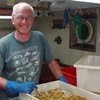General Description
Carapace covering the head and all thoracic legs. Eight pairs of thoracic legs modified for swimming, each has two branches with long setae (hairs) along each branch and a frilly gill near the base.
Biology
Krill are pelagic filter feeders on minute phytoplankton, zooplankton and detritus suspended in the water. The feeding mechanism of krill is a basket formed by the feathery thoracic legs, the inner margins of which are provided with long stiff hairs called setae. Krill usually occur in dense swarms and in Australian waters rafts of Nyctiphanes australis, covering several hectares, may occur at the surface where they are fed upon by muttonbirds (Sooty Shearwaters). Sometimes millions of krill are washed ashore on beaches where they die to form a silvery tidemark. Larger krill are the prime source of food for baleen whales like the Humpback.
Habitat
Pelagic to about 100 m depth.
Open water
Distribution guide
Southern temperate oceans, including New Zealand to Snares Islands and south-eastern Australia.
Species Group
Prawns, shrimps, lobsters › Krill
Depth
Shallow (1-30 m)
Deep ( > 30 m)
Water Column
Max Size
Diet
Organic matter
Commercial Species
No
Global Dispersal
Recorded in Australia
Conservation Status
- DSE Advisory List : Not listed
- EPBC Act 1999 : Not listed
- IUCN Red List : Not listed





